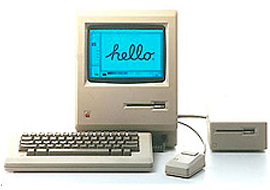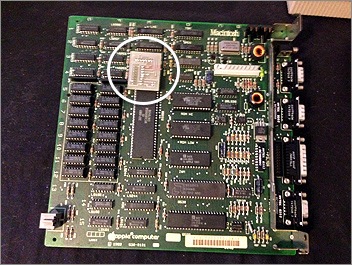The 128k Mac Hidden in Plain Sight

Things usually don’t happen this way.
Old computers need to be turned on every so often, to make sure they still work and keep the innards from decaying beyond repair. A couple months ago I decided to dust off and go through this exercise with some of my old Macs. Most worked fine, but a 512k and Mac Plus (two of the oldest models in the collection) showed no life on screen after the power-on chime. That usually means a failed component on the analog board.
I gathered up a few spare parts and began the repair process, beginning with the 512k. The rear case on this one just said “Macintosh” rather than “Macintosh 512k”. But this was not unusual for this era, many 128k models were upgraded to Fat Macs back in the day. I removed the Torx T15 screws and popped the enclosure open with my case cracker.
I knew the logic board was OK, so I decided to just remove it and install in another spare classic Mac which had a working analog board. But after disconnecting the cables and extacting the motherboard, I noticed it wasn’t what I expected. Rather than being a 512k logic board, this was actually an original 128k motherboard. The rear case wasn’t a mistake. But it had an 800k floppy drive installed internally, so that threw me off. I must have inherited this model before I knew how to verify the difference, then never subsequently checked.
Wow – a 128k Mac, sitting on my shelf for over 10 years. And all these years I thought it was a 512k. Things usually don’t happen this way.
I installed the motherboard in the new chassis, put the rear case back on, and popped in a System 1.0 floppy disk. Chime, whirr, chocka chocka, and there it was – 1984 in all its glory. Sitting in plain site the whole time!
There are some odd things about this unit. A small daughterboard is soldered next to the Motorola 68000 CPU – I have no idea what this is for. Also I didn’t realize that 800k floppy drives worked with pre-Mac Plus motherboards, at least for 400k disks. That’s good to know.
A very serendipitous find. I really had no idea this wasn’t a stock 512k. Wonder what else I have in my own collection that I don’t know about!



What you have is simply the original logic board where the factory Apple-logo RAM was removed and replaced with higher capacity. From there a second raised board, as you have, is installed to address the additional RAM. This is a later motherboard too, early ones had the purple/gold Motorola processor. But it is still, none the less, an original 128 k mono since there is no area to mark it for either 128k or 512k. The only other thing I can add is while this machine is complete with upgrade, it may not be the original motherboard that came in that box. There is a chance that when the owner upgraded the board was sent in. To speed up turn around companies would send back an already upgraded board. Strangely though your board is missing a resistor pack that would have been awkwardly soldered to the IC just above the barcode label. Most original Macs had this added to prevent an issue, and it was almost always done when upgraded even by a third party.
Yes you’re correct – after posting this entry I re-examined the board and it does indeed have 512MB of socketed RAM. It’s an upgraded original 128k motherboard – not quite the what I thought, but still a fairly rare thing. Do you know what the small raised board does exactly to allow addressing of additional RAM?
I am not tech savvy enough to understand the functions of the ICs. So I can not say for sure how it works. I will add that on an unmolested board there are solder points in the open for this small card to solder too. From what I recall, the engineers were uneasy with the limited 128k of RAM. But Jobs, wanting to keep costs down, insisted on 128k. The engineers designed the board to make it easy to upgrade knowing the RAM may not be enough and that prices would drop. Weather or not the engineers planned on the installation of a daughter card is unknown. They may have had other ideas.
I also want to add you mention it has an 800k floppy drive. Maybe it does, and it may work for reading. But if you try to format and it fails, then the ROMS are probably original 128k ROMs. I point this out, because from the picture the ROMS appear to be original 128k pieces! If they are, the machine is even closer to being pretty much stock 128k (less RAM upgrade). If you post the serial under the front “chin” of the case I can give you the production date!
The Mac design team definitley knew that 128k wasn’t enough RAM, all development prototypes had used 512k. The decision to go with 128k was made for cost, yes, though I don’t believe by Jobs himself. The 512k Fat Mac model shipped a few months later, and most original 128k systems were upgraded.
I’m not surprised the 800k drive can’t be used to write floppies. Frankly I’m surprised it works at all! This system is definitely not stock, it doesn’t have all original pieces (some of my own mix and match). The serial number sticker on this one isn’t representative of the original model.
Also because it took some time to ramp up production to the volumes Apple needed.